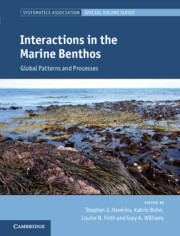Book contents
- Interactions in the Marine Benthos
- The Systematics Association Special Volume Series
- Interactions in the Marine Benthos
- Copyright page
- Contents
- Preface
- Contributors
- Chapter 1 Introduction
- Chapter 2 The Intertidal Zone of the North-East Atlantic Region
- Chapter 3 The Ecology of Rocky Subtidal Habitats of the North-East Atlantic
- Chapter 4 Rocky Intertidal Shores of the North-West Atlantic Ocean
- Chapter 5 Subtidal Rocky Shores of the North-West Atlantic Ocean
- Chapter 6 Shallow Water Muddy Sands of the North-West Atlantic Ocean
- Chapter 7 Biodiversity and Interactions on the Intertidal Rocky Shores of Argentina (South-West Atlantic)
- Chapter 8 Species Interactions and Regime Shifts in Intertidal and Subtidal Rocky Reefs of the Mediterranean Sea
- Chapter 9 The Restructuring of Levant Reefs by Aliens, Ocean Warming and Overfishing
- Chapter 10 North-East Pacific
- Chapter 11 The North-East Pacific
- Chapter 12 Consumer–Resource Interactions on an Environmental Mosaic
- Chapter 13 Where Three Oceans Meet
- Chapter 14 Rocky Shores of Mainland China, Taiwan and Hong Kong
- Chapter 15 Biogeographic Comparisons of Pattern and Process on Intertidal Rocky Reefs of New Zealand and South-Eastern Australia
- Chapter 16 The Past and Future Ecologies of Australasian Kelp Forests
- Chapter 17 Kropotkin’s Garden
- Chapter 18 Biofilms in Intertidal Habitats
- Chapter 19 Interactions in the Deep Sea
- Chapter 20 Overview and Synthesis
- Index
- Systematics Association Special Volumes
- References
Chapter 15 - Biogeographic Comparisons of Pattern and Process on Intertidal Rocky Reefs of New Zealand and South-Eastern Australia
Published online by Cambridge University Press: 07 September 2019
- Interactions in the Marine Benthos
- The Systematics Association Special Volume Series
- Interactions in the Marine Benthos
- Copyright page
- Contents
- Preface
- Contributors
- Chapter 1 Introduction
- Chapter 2 The Intertidal Zone of the North-East Atlantic Region
- Chapter 3 The Ecology of Rocky Subtidal Habitats of the North-East Atlantic
- Chapter 4 Rocky Intertidal Shores of the North-West Atlantic Ocean
- Chapter 5 Subtidal Rocky Shores of the North-West Atlantic Ocean
- Chapter 6 Shallow Water Muddy Sands of the North-West Atlantic Ocean
- Chapter 7 Biodiversity and Interactions on the Intertidal Rocky Shores of Argentina (South-West Atlantic)
- Chapter 8 Species Interactions and Regime Shifts in Intertidal and Subtidal Rocky Reefs of the Mediterranean Sea
- Chapter 9 The Restructuring of Levant Reefs by Aliens, Ocean Warming and Overfishing
- Chapter 10 North-East Pacific
- Chapter 11 The North-East Pacific
- Chapter 12 Consumer–Resource Interactions on an Environmental Mosaic
- Chapter 13 Where Three Oceans Meet
- Chapter 14 Rocky Shores of Mainland China, Taiwan and Hong Kong
- Chapter 15 Biogeographic Comparisons of Pattern and Process on Intertidal Rocky Reefs of New Zealand and South-Eastern Australia
- Chapter 16 The Past and Future Ecologies of Australasian Kelp Forests
- Chapter 17 Kropotkin’s Garden
- Chapter 18 Biofilms in Intertidal Habitats
- Chapter 19 Interactions in the Deep Sea
- Chapter 20 Overview and Synthesis
- Index
- Systematics Association Special Volumes
- References
Summary
The rocky shores of New Zealand (NZ) and Australia provide many interesting comparisons in their intertidal species and structuring processes. Both countries are in the biogeographic realm of temperate Australasia and share many common species and closely related taxa. Here we review similarities and contrasts in communities and structuring processes, especially involving grazing invertebrates and macroalgae. We consider the similarity of the structure of intertidal shores of NZ and south-eastern Australia, a suite of important trophic interactions within and between regions, the utility of local-scale experiments in understanding large-scale processes and how we might better plan for and manage our coasts. The major comparisons are between warm-temperate areas of northern NZ and New South Wales, and the cooler areas of southern NZ and south-eastern Australia. In the quest for ‘ecosystem’-level understanding, which perforce involves large-scale events, there is an increasing tendency to minimise or ignore the hard-won insights gained from well-structured experiments across multiple sites. Because all large-scale effects must be manifested at local sites, it is incumbent on us to determine what scales up or down, and the caveats that make comparisons across biogeographic regions challenging. Here, we discuss these issues using austral shores as models.
Keywords
- Type
- Chapter
- Information
- Interactions in the Marine BenthosGlobal Patterns and Processes, pp. 391 - 413Publisher: Cambridge University PressPrint publication year: 2019
References
- 3
- Cited by



